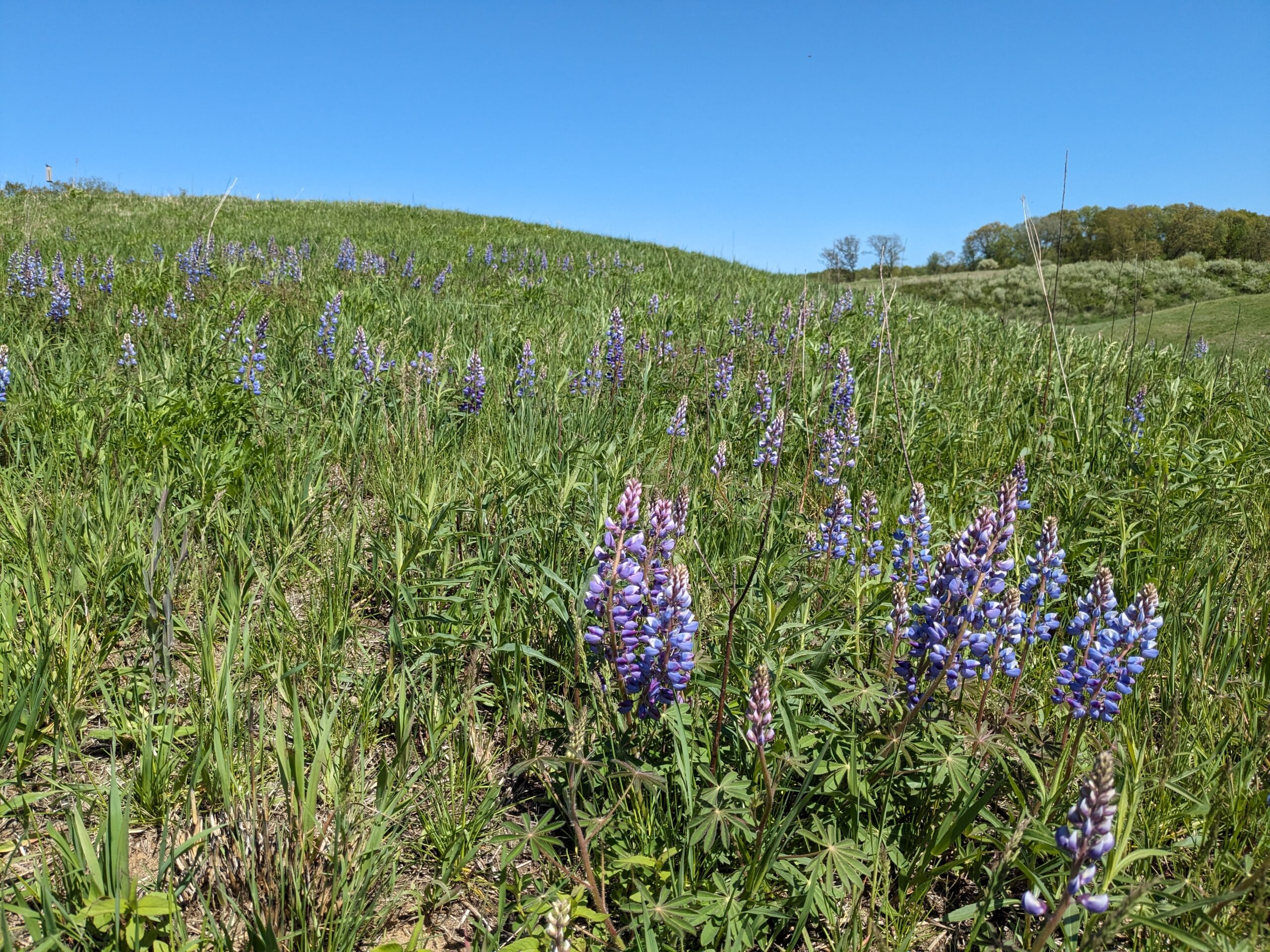Conservation Manager Chad Machinski, M.S., joined the Michigan Audubon team in March of 2023 and has made great progress in reviving the stewardship of MA’s sanctuaries and engaging with our dedicated volunteers ever since. To help you stay connected with the work being done, he will be presenting regular online updates about activities going on at them: birds seen or heard, conservation work, improvements, interesting plants, and more.
While it seems that I just wrote my last update, much activity has happened since then. Six sanctuaries have been visited in the past three weeks, birds are really pouring in, invasives have been pulled, trash has been picked up, and the plants have grown…oh how the plants have grown!
MARTHA MOTT SANCTUARY
Our Martha Mott Sanctuary in Mattawan saw a significant turnout of volunteers at the end of April. Their dedicated efforts in trash pick up along the road frontages resulted in the collection of about five industrial trash bags of litter from the ditches and along the fence. This collective action not only improved the sanctuary’s appearance but also contributed to the well-being of the local ecosystem. In addition to this, 24 species of birds were observed there that morning, including nest building by a pair of Blue Jays. Nest boxes that were installed a few months prior are now being occupied by Bluebirds, Black-capped Chickadees, and Tree Swallows. More recently, two species have been added to Martha Mott’s all-time bird list: a Northern Waterthrush and a Northern Harrier. Both were seen at the southern boundary of the sanctuary near the Hayden Creek wetland. In addition, a visitor to the sanctuary observed a Red-headed Woodpecker. This is the first recorded observation of this species at the sanctuary since 1977 and one that we are working to have as an established breeder there.
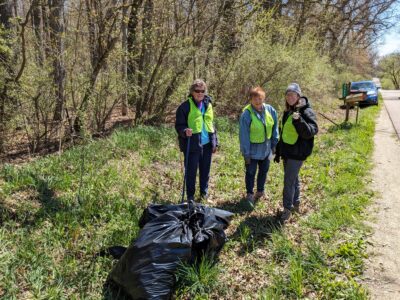
From left to right, Karen Zantjer, Ellie Klemm, and Murphy Harrington pose behind trash bags filled with trash from along the roads in front of Martha Mott Sanctuary. Murphy is holding a baseball she found. Not pictured is volunteer Dean Pollee, who also participated in the workday. Photo by Chad Machinski
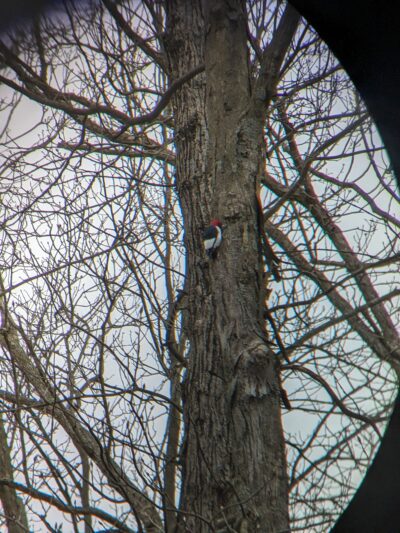
A Red-headed Woodpecker was spotted on a tree just over the property line at Voorhees Brothers Sanctuary. Four in total were documented. Photo by Chad Machinski
VOORHEES BROTHERS SANCTUARY
Speaking of Red-headed Woodpeckers, they remained a reliable species seen at our Voorhees Brothers Sanctuary in Marshall. Four birds were seen around the short trail there and continued to be seen as I traversed the site, seeking out the few individual garlic mustard plants and invasive shrubs (Japanese barberry and multiflora rose). Updates and repairs to the entry boardwalk will be coming this year.
CAPITAL CITY BIRD SANCTUARY
The Capital City Bird Sanctuary has seen great efforts recently. On the eve of Arbor Day, dedicated volunteers planted 15 native trees (sugar maple and American beech) given to us by the Mid-Michigan Land Conservancy. These trees, among other species yet to be planted, will help transform an area dominated by scotch pine into a space more reminiscent of a mesic forest. After the rapid tree planting by volunteers, we hopped out to the road frontage and picked up several bags worth of trash. Volunteers have also made great strides in reducing garlic mustard in areas where it has not yet carpeted the forest floor. Herbicide treatments of the invasive fig buttercup also took place in the short window when the plants were receptive to the herbicide. It is important to keep this species in check, or else we risk losing many of the spring ephemerals found there. Following a report from a sanctuary visitor, I was on the lookout for chickens on the property and eventually found four young bantam roosters. Due to the location where they were found, it’s believed the roosters had been abandoned there purposefully. They have been removed from the property and are currently in a temporary home.

Volunteers planting 15 sugar maple and beech trees at Capital City Bird Sanctuary. Pictured are Charlene VanAcker, Charlene Avery, Robert Shaver, Jacob Zokvic, Katie Hanson, and Eric Hanson. Photo by Chad Machinski
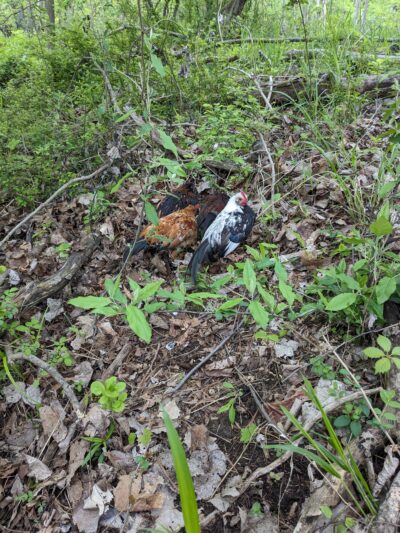
Capital City Sanctuary 5/9/2024. Four Bantam Roosters found near river (Unit S1) by Box #20. They were trapped and taken to temporarily live at Chad Machinski's house. Photo by Chad Machinski
KATE PALMER WILDLIFE SANCTUARY
Allen King, a steward for Kate Palmer Wildlife Sanctuary, held a workbee event in late April that saw the trimming back of trails on the east side of Sandstone Creek. Kate Palmer is such a wonderful sanctuary to visit in spring. The high water table and Sandstone Creek provide sufficient water for the lush greens of skunk cabbage, trillium, trout lily, bloodroot, and more.
OTIS FARM BIRD SANCTUARY
While the evidence of bird migration was apparent at all sanctuaries, it was most apparent at our Otis Farm Bird Sanctuary in Hastings. I ended the day with 42 species of birds there. The buzzing of Blue-winged Warblers was noticeable the moment I got out of my car, cuckoos called from their obscured perches in the tree tops, and Common Yellowthroats bounced around in the dense shrubbery. The highlight, however, was a glance at a Yellow-breasted Chat. Tipped off by volunteer and tour leader Doug Klein of its return, I went looking. I had given up hope of seeing it in its usual location and actually turned around to resume my walk when it flew through an open area over the trail, never to be seen by me again. These sightings, coupled with the beginning blooms of wild lupine (Lupinus perennis) in the section of prairie that was burned last fall, made this a wonderful visit to Otis.
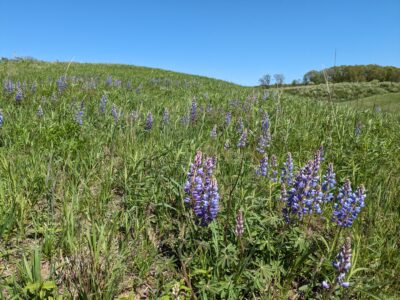
Lupine blooming in a western portion of Otis Farm Bird Sanctuary that was burned in November 2023. Photo by Chad Machinski
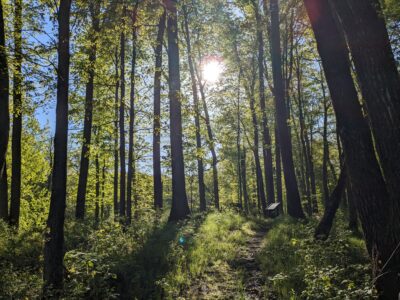
A view from the Green Trail looking east at Otis Farm Bird Sanctuary. Photo by Chad Machinski
CHIMNEY SWIFTS
Besides the sanctuaries, I’ve also made visits to a specific chimney here in Lansing. The chimney at Smith’s Floral & Greenhouse is a well-known roost for Chimney Swifts. While the fall seems to be the time that most folks are thinking about Chimney Swifts as they begin to head south, spring is still an opportune time to see them roosting. My two visits to this specific chimney have yielded 145 and 206 Swifts entering the chimney at dusk. Arriving well ahead of time, it is a treat to watch the swifts slowly begin to coalesce into a stream that begins to flow right into the chimney. Often, one swift will enter much earlier than the rest to claim the best brick in the house and for several minutes after the main stream, stragglers will continue to come by in ones and twos to find their place in the crowded chimney. I encourage anyone who has a known roost they can visit to check it out at dusk and add your observations to our Confirmed Roost Survey form to help us gain a better understanding of where Chimney Swifts are in Michigan.
To learn more about Michigan Audubon sanctuaries, visit michiganaudubon.org/conservation/bird-sanctuaries. If you want to volunteer at a Michigan Audubon sanctuary, please complete the Sanctuary Volunteer Interest Form.

Chad Machinski, MS
Conservation Manager
While Chad’s first love is botany, he doesn’t deny the intertwining nature of birds, plants, insects, and all other organisms we share the world with. His passion for the natural world began in his undergraduate time at the University of Michigan, taking several different forms along the way. His graduate studies at the University of Michigan allowed him to more closely examine the natural communities of Michigan and further understand the complex nature of ecosystems. His work as a Nichols Arboretum Caretaker while in school further enabled him to be directly involved in conservation work as he led workdays removing invasive plant species, performed trail maintenance, and guided tours. Chad can usually be found out in a park in a few ways: binoculars glued to his face, hunched over looking at plants, or flipping logs looking for snakes and salamanders.

